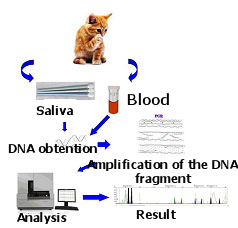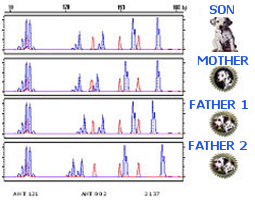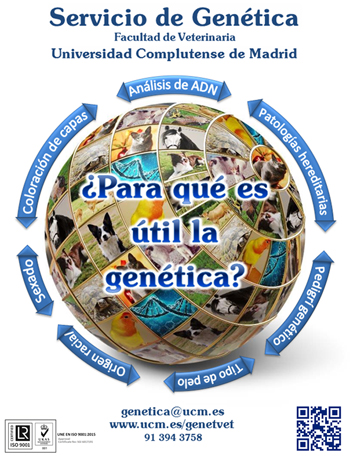GENETIC IDENTIFICATION AND PARENTAGE CONTROL IN SPECIES OF DOMESTIC ANIMALS BY MOLECULAR TECHNIQUES
|
Description |

Schematic representation of methodology followed for genetic identification.
The genetic identification and paternity testing using molecular techniques in species of pets (dogs, cats) and livestock (cows, sheep, goats and horses) is based on microsatellite DNA markers. or STR.
The "genetic fingerprint" is obtained from a few drops of blood or saliva, which is characteristic of the animal and almost unique in the population to which it belongs. Compared with their parents/children, it can be contrasted the ancestry/descent and performed the paternity test.
|
How does it work |

Contrast of the genetic profile of a cub compared to the two possible parents.
The microsatellite analysis is a simple, fast and low cost technique that can be performed from any sample that contains nucleated cells. The procedure is as follows: first we carry out a DNA isolation and next we perform an enzymatic amplification of the genetic markers by the PCR technique. The analysis of these amplified fragments results to what is named "DNA fingerprinting" or "genetic fingerprint" which is similar to a barcode and is characteristic of each animal.
Due to the large marker polymorphisms, there is a very large number of possible combinations of alleles, which makes it difficult that two individuals have the same and, therefore, it is possible to distinguish them. It is a very powerful and 'universal' method for identification that remains throughout the life of the animal, and it is unfalsifiable, so in the case of loss, theft or dispute, it could unequivocally be identified.
The genetic analysis of paternity, the genetic pedigree or the paternity testing, is based on the testing of the genetic fingerprint of an animal with their ancestors or their parents. For each marker, the 2 alleles that an individual presents, one has been inherited from the mother (in whose veracity, in many cases, there is no question) and the other from the biological or true father. If this analysis is made for a 15-20 set of markers, the power of paternity exclusion is very high, close to 100%. If the alleged father is rejected as the biological father, the result is categorical and absolute.
|
Advantages |
Determining the "genetic fingerprint" or "DNA fingerprinting" allows both identify animals by a universal highly polymorphic and unfalsifiable method, which lasts throught the animal's life, and verify or certify the ancestors or offspring of animals by comparison with the genetic fingerprint of their parents or offspring.
The low necessary biological sample (just 25 µl of blood), the high polymorphism of these markers over other previously used, and ease of determining unequivocally, makes the techniques more and more routinely used for recording animals in herd books of different breeds, to verify their identity and ensure racial purity.
The ease, quickness of determination and low cost make it ideal for the generalization in breeders Associations, breed clubs, farms, and individuals of different animal species.
|
Where has it been developed |

UCM Genetics Service.
The Genetic Service of the Veterinary Medicine Faculty, Universidad Complutense de Madrid, has been offering these services since 1996. Since its launch, the demand for genetic identification and parentage controls have emerged both from individuals and from different breeders associations as ASEAVA (Spanish Association of Selected Beef Cattle of Asturiana de los Valles Breed), ACPRA (Spanish Association of Pony Breeders of Asturcón Breed), the Spanish Federation of Hunting, the Royal Societies Canines of Spain and Catalonia, the Spanish Federation of Greyhounds or the Circle of Hunters and Breeders Pachón Navarro, and institutions like the Department of Environment of the Community of Madrid and Castilla y León, or the Department of Livestock, Agriculture and Fisheries of Cantabria are examples that clearly indicate the wide range of possibilities and the interest it arouses.
The technological basis of this Genetic Service is supported by the research that the authors have conducted over the past 20 years and spread through numerous scientific publications in relevant journals, counting also with extensive experience in collaborations with companies and associations.
We are part of the group "Animal Nutrigenomics" of the Animal Production Department, Faculty of Veterinary Medicine, of the UCM, directed by Susana Dunner. This research group is included in the cluster of Agri-food and Health of the International Excellence Campus (CEI-Moncloa).
[More information about the department and research group]
|
And also |
The Genetic Service of the Veterinary Medicine Faculty of Madrid, offers support to daily clinical activities (paternity testing, genetic identification, sexing birds by molecular techniques,…) and other professionals for other purposes (genetic evaluation, estimation of genetic parameters, etc.).
The increasing globalization of knowledge of what these genetic techniques can offer is leading to various companies and organizations, as well as breeders and owners, to consider the need to verify the genealogy of the animal that they acquired or sold, and to establish the 'racial purity' or genetic origin of the animals.
|
Contact |
|
© Office for the Transfer of Research Results – UCM |
|
PDF Downloads |
|
Classification |
|
Responsible Researcher |
Javier Cañón Ferreras: genetica@vet.ucm.es
Department: Animal Production
Faculty: Veterinary Medicine


